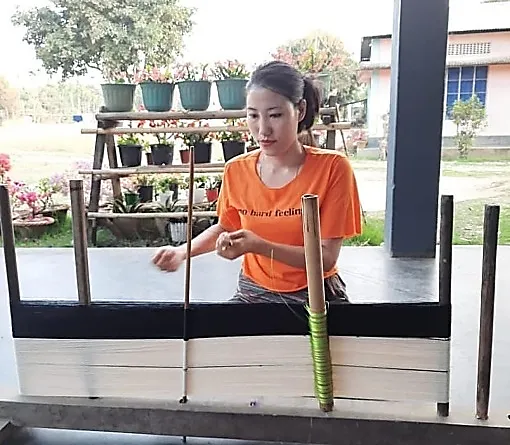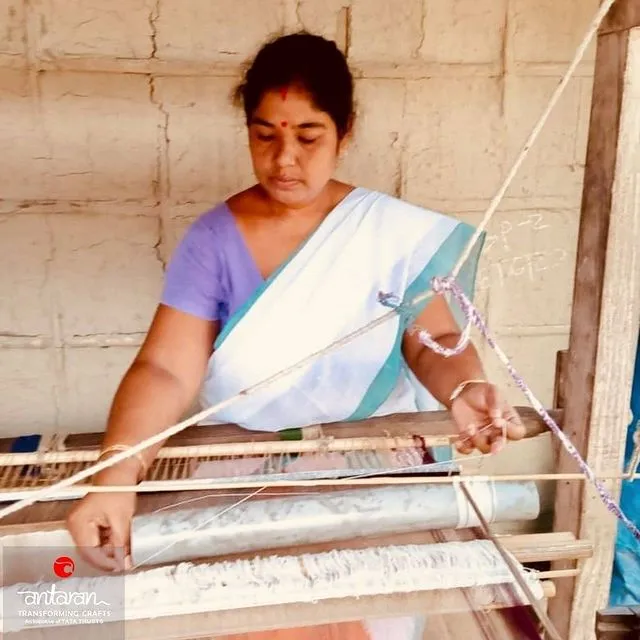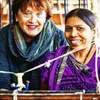How Tata Trusts’ Antaran programme is empowering artisans, rejuvenating the handloom sector
Antaran-Transforming Crafts is a craft-based livelihood programme by Tata Trusts. It works with artisans to create awareness on their crafts, with an objective to make the handloom sector self-sustaining and to support artisan’s journey into entrepreneurship.
Lovitoli from Dimapur, Nagaland, learnt the art of weaving at a young age and made it an integral part of her livelihood. She believes it’s important to conserve traditional and cultural pride, and wishes for Loin Loom weaving, also called the back-strap weaving, to reach out to more people. Her mission is to conserve, earn, create, and excel in weaving.
Today, Lovitoli is one of the young artisan entrepreneurs in the Antaran Programme who has successfully established her enterprise and has involved many young girls in her community as associate weavers. With the help of Antaran, she realised that with Loin loom weaving, one need not only weave traditional Mekhelas, but they can also explore various other products like lifestyle and home decor.

Lovitoli from Dimapur, Nagaland
She is one of the Change Leaders who has motivated many young girls in her region to take up weaving as a profession.
Like Lovitoli, Antaran has empowered many artisans from the handloom clusters of Assam, Nagaland, Odisha, and Andhra Pradesh.
The mission
Antaran engages with weaver communities through incubation and by setting up design centres in the clusters for the development of education, enterprises, and ecosystems. Its mission is to enable weaving communities to sustain their culture with systematic education and ecosystem building and to create contemporary designs with traditional techniques for sustainable livelihoods through craft.
The overarching objective is to create artisan-led microenterprises that will sustain traditional craft through innovation and create a lucrative profession for the younger generation.
“We found in our studies that though there have been organised initiatives, the situation remains the same as each of the issues that hail the craft has not been addressed systematically, and most importantly, an entrepreneurial approach has to be taken for sustainable growth. In groups and collectives, the individual drive and freedom for taking responsibilities and decisions get limited, making the groups not agile enough to respond to market realities,” says Mridula Tangirala, Head of Tourism and Head of Crafts, Tata Trusts.
The team organises several community mobilisation drives, where it explains the community the importance of education to build their businesses. Its Incubation and design centres work as education and business development hubs for artisans, helping build a community of micro-entrepreneurs across the handloom value chain in each region. A full-time expert team with professionals from business, textile design, and technical backgrounds facilitate the process.
Empowering artisans
Almost every state in India has its own unique handloom weaves. Handloom is also the second-largest traditional livelihood in India after agriculture.
As per the Handloom Census of 2019 -2020, there are over 43 lakh weavers and allied workers employed in the Indian handloom industry. While there are many weaver families who have had to abandon the craft for regular work, they could only get back with increased markets. Moreover, 72 percent of handloom weavers are women.

A woman artisan crafting the most soft and delicious, natural dyed Ahimsa silk fabrics.
Tata Trusts works on multi-thematic community development issues on an ongoing basis. Arts, crafts, and culture have always been a focus area, and are cognizant of craft development as a major tool for rural empowerment.
“We are standing at a critical juncture, with the alarming pace at which handloom weavers, particularly young ones, are drifting away from the sector. Precious skills of centuries would be soon lost with weavers in rural areas having to abandon the craft for want of proper returns. While there is no denying that the entire craft sector is reeling under pressure from cheap goods made by machines, it is equally true that there are misgivings attributed to the way artisans and their market interfaces have responded to the changing circumstances,” adds Mridula.
Antaran works towards strengthening craft ecosystems, building core strength of handloom textiles such as natural fibres, hand-spun yarn, and natural dyes, while reviving and reinterpreting the traditional weave designs in these selected clusters for wider markets. Artisans can learn about design and business and are empowered toward entrepreneurship and self-employment.

An artisan operating a loom -crafting silk sarees
The team on the ground along with professional marketers help equip the artisans with tools and resources to enable them to work with buyers directly. Innovation is a key focus area with a team of designers and marketers constantly working with the artisans, guiding them to explore their creativity, and learn about markets, quality, and professionalism to develop textiles with their skills and reinterpreting them in a contemporary context.
Indian Handlooms also have the potential to play a much bigger role given the right environment, as the conscious world is moving towards slow fashion and sustainability.
“Handlooms require very little resources and have a minimal carbon footprint as compared to fast fashion, with the production of cheap textiles in mass quantities adversely affecting the environment. However, in the rush to automate the world, artisans are being replaced by machines today, which is leading to poverty and job losses. This energy-saving art form has secured India’s presence in millions of homes globally. A presence that has been crafted by dexterous hands, many of whom belong to marginalised sections of the Indian society,” Mridula tells SocialStory.
Challenging times
Many artisans are new to digital formats to do business, and this was a challenge, especially during the pandemic. Covid-19 created a situation where they had to handle everything digitally and almost independently put it to direct practical use.
Most artisans have done business during exhibitions in a B2C setup, with an over-the-counter arrangement. They did not have new generation phones, computers, and smooth network connectivity in rural interiors. Most of them were also not equipped to move to digital transactions quickly, but have been managing well.

Live demonstrations of the indigenous weaving technique of loin loom weaving of Nagaland
“This was where education through the Antaran programme came in handy. They were quick to adapt to handling digital payments independently with close guidance from team members, and through this they have been successfully handling Paytm, PhonePe, GooglePay, and NEFT/IMPS transfers. Artisans were trained on the use of digital platforms under close guidance and perhaps as a secondary tool,” Mridula explains.
At the cluster level, the availability of dyeing facilities for customised colours as per market needs has been another challenge. The availability of yarns in various counts and fibres for innovation is also difficult for the artisans. Each cluster has its own set of challenges in this aspect depending on the weave techniques and the fibres that would be conducive for them to adapt as per market needs.
Impacting lives
In the past four years, Antaran claims to have nurtured around 200 artisan entrepreneurs through its education and development programme across the six clusters, who in turn have passed on the knowledge to more than 2,000 artisans.
To further continue creating conditions for artisans to interact/transact with markets directly, Antaran Artisan Connect marketplace has been created to connect artisan entrepreneurs with retail buyers directly. This has acted as a major relief for them to handle the market setback during the times of the Covid-19 crisis.
The long-term objective of this intervention is to continue equipping these clusters with the necessary tools to deal with the evolving market scenarios, especially in the digital space and thus become self-sufficient, thereby creating entrepreneur-led microenterprises across each element of the value chain.
Edited by Megha Reddy


1562933021919.jpg?fm=png&auto=format&h=100&w=100&crop=entropy&fit=crop)





